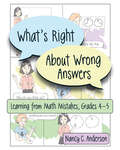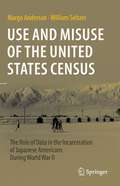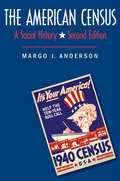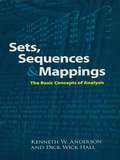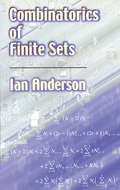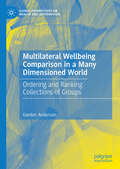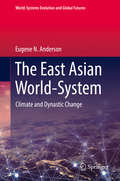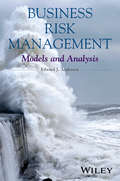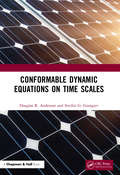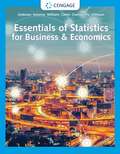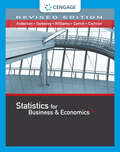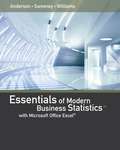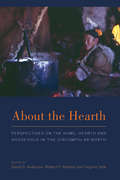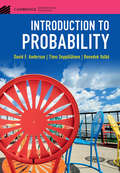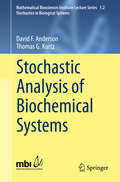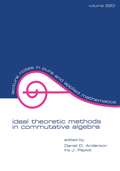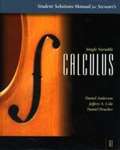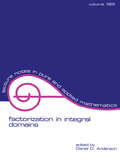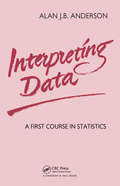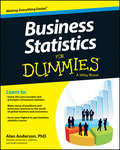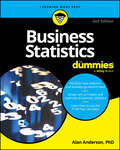- Table View
- List View
What's Right About Wrong Answers: Learning From Math Mistakes, Grades 4-5
by Nancy AndersonYou can&’t learn to hit a three-point shot without missing a lot of shots. You can&’t learn to play a piece of music correctly without striking a lot of wrong notes. And, as Nancy Anderson explains in What&’s Right About Wrong Answers: Learning From Math Mistakes, Grades 4-5 , You can&’t learn math without making mistakes. Anderson turns mistakes on their head and helps you cleverly use them to students&’ advantage. Each of the twenty-two activities in this book focuses on important ideas in grades 4 5 mathematics. By examining comic strips, letters to a fictitious math expert from confused students, and sample student work containing mistakes, your learners explore typical math mistakes, reflect on why they&’re wrong, and move toward deeper understanding. Each activity includes: A summary of the mathematical content and highlighted error Common Core connections Prerequisite knowledge that students need Big underlying math ideas Suggestions for implementing the activity Each activity can be used to enhance units of instruction and help students prepare for assessments that are aligned with the Common Core and similar state standards.
Use and Misuse of the United States Census: The Role of Data in the Incarceration of Japanese Americans During World War II
by Margo Anderson William SeltzerThe U.S. government conducts a population census every 10 years, adds up the counts by geographic location, and uses the resulting numbers in formulas to allocate seats in the House of Representative and Electoral College, and to make public funding and tax decisions. It has served as an essential tool of representative democracy since 1790. The raw data from the census also serve as a decennial snapshot of the nation, a very long list, organized by household, ideally of all people resident on census day, with additional information on the name, age, race, sex, geographic location, and other characteristics for each individual. Americans recognized early in their history that the raw data, the list, could serve additional governmental functions, and over the centuries, erected guardrails to prevent improper use. They are encapsulated in the presidential proclamations announcing the upcoming census. The information collected from individual households is for aggregated use only, and cannot be used for the “taxation, regulation, or investigation” of individual persons or businesses. Americans have heeded the call to “stand up and be counted.” They also engage in an ongoing conversation to make sure that the information is used properly and ethically, that the census serves as a tool of representative democracy and advances the rights – including human rights -- of all Americans. The record, however, reveals that there have been failures to meet this goal and that as a result the information provided by the responding public sometimes has been misused, causing considerable harm to vulnerable individuals, groups and entities. Today, as governments and social media are suspect for their exploitation of data about individuals, the experience of Americans of Japanese ancestry in the United States during World War II provides a chilling example of such misuse of census data. This book reveals how census officials stepped beyond their normal roles as unobtrusive monitors of American demographic life and helped justify and administer the relocation and incarceration program. Census officials mobilized the substantial administrative and technical resources of the 1940 census, to map the neighbourhoods where Japanese-Americans lived, and planned their systematic removal. The officials then built “census-like” data systems to track the “evacuees” for the duration of the war, monitor their lives in the camps, and certify which “loyal” evacuees might be released from the camps for military or civilian service. After the war, census officials drafted an official history of their activities, but did not publish it. This book has lessons for policy makers and ordinary Americans alike, as we confront the new digital world in which we live. And it speaks to two of the great issues of our time: distrust in the institutions of government and the victimization of minorities.
The American Census
by Margo AndersonThis book, published on the eve of the bicentennial of the American census, is the first social history of this remarkably important institution, from its origins in 1790 to the present. Margo Anderson argues that the census has always been an influential policymaking tool, used not only to determine the number of representatives apportioned to each state but also to allocate tax dollars to states, and, in the past, to define groups-such as slaves and immigrants-who were to be excluded from the American polity.
Sets, Sequences and Mappings: The Basic Concepts of Analysis
by Kenneth Anderson Dick Wick HallStudents progressing to advanced calculus are frequently confounded by the dramatic shift from mechanical to theoretical and from concrete to abstract. This text bridges the gap, offering a systematic development of the real number system and careful treatment of mappings, sequences, limits, continuity, and metric spaces.The first five chapters consist of a systematic development of many of the important properties of the real number system, plus detailed treatment of such concepts as mappings, sequences, limits, and continuity. The sixth and final chapter discusses metric spaces and generalizes many of the earlier concepts and results involving arbitrary metric spaces.An index of axioms and key theorems appears at the end of the book, and more than 300 problems amplify and supplement the material within the text. Geared toward students who have taken several semesters of basic calculus, this volume is an ideal prerequisite for mathematics majors preparing for a two-semester course in advanced calculus.
Math Trailblazers: Grade 4 Student Guide
by Kathleen R. Anderson Anne Roby Lindy M. Chambers-BoucherNIMAC-sourced textbook
Integrated Approaches to STEM Education: An International Perspective (Advances in STEM Education)
by Judy Anderson Yeping LiThis book provides a platform for international scholars to share evidence for effective practices in integrated STEM education and contributes to the theoretical and practical knowledge gained from the diversity of approaches. Many publications on STEM education focus on one or two of the separate STEM disciplines without considering the potential for delivering STEM curriculum as an integrated approach.This publication analyzes the efficacy of an integrated STEM curriculum and instruction, providing evidence to examine and support various integrations. The volume focuses on the problems seen by academics working in the fields of science, technology, engineering and mathematics (STEM) and provides valuable, high quality research outcomes and a set of valued practices which have demonstrated their use and viability to improve the quality of integrated STEM education.
Combinatorics of Finite Sets (Dover Books on Mathematics)
by Ian AndersonCoherent treatment provides comprehensive view of basic methods and results of the combinatorial study of finite set systems. The Clements-Lindstrom extension of the Kruskal-Katona theorem to multisets is explored, as is the Greene-Kleitman result concerning k-saturated chain partitions of general partially ordered sets. Connections with Dilworth's theorem, the marriage problem, and probability are also discussed. Each chapter ends with a helpful series of exercises and outline solutions appear at the end. "An excellent text for a topics course in discrete mathematics." -- Bulletin of the American Mathematical Society.
Multilateral Wellbeing Comparison in a Many Dimensioned World: Ordering and Ranking Collections of Groups (Global Perspectives on Wealth and Distribution)
by Gordon AndersonThis book addresses the disparities that arise when measuring and modeling societal behavior and progress across the social sciences. It looks at why and how different disciplines and even researchers can use the same data and yet come to different conclusions about equality of opportunity, economic and social mobility, poverty and polarization, and conflict and segregation. Because societal behavior and progress exist only in the context of other key aspects, modeling becomes exponentially more complex as more of these aspects are factored into considerations. The content of this book transcends disciplinary boundaries, providing valuable information on measuring and modeling to economists, sociologists, and political scientists who are interested in data-based analysis of pressing social issues.
The East Asian World-System: Climate and Dynastic Change (World-Systems Evolution and Global Futures)
by Eugene N. AndersonThis book studies the East Asian world-system and its dynastic cycles as they were influenced by climate and demographic change, diseases, the expansion of trade, and the rise of science and technology. By studying the history of East Asia until the beginning of the 20th century and offering a comparative perspective on East Asian countries, including China, Japan and Korea, it describes the historical evolution of the East Asian world-system as being the result of good or poor management of the respective populations and environments. Lastly, the book discusses how the East Asian regions have become integrated into a single world-system by a combination of trade, commerce, and military action. Given its scope, the book will appeal to scholars of history, sociology, political science and environmental studies, and to anyone interested in learning about the effects of climate change on the dynamic development of societies.
Business Risk Management
by Edward J. AndersonA comprehensive and accessible introduction to modern quantitative risk management.The business world is rife with risk and uncertainty, and risk management is a vitally important topic for managers. The best way to achieve a clear understanding of risk is to use quantitative tools and probability models. Written for students, this book has a quantitative emphasis but is accessible to those without a strong mathematical background.Business Risk Management: Models and AnalysisDiscusses novel modern approaches to risk managementIntroduces advanced topics in an accessible mannerIncludes motivating worked examples and exercises (including selected solutions)Is written with the student in mind, and does not assume advanced mathematicsIs suitable for self-study by the manager who wishes to better understand this important field. Aimed at postgraduate students, this book is also suitable for senior undergraduates, MBA students, and all those who have a general interest in business risk.
Conformable Dynamic Equations on Time Scales
by Douglas R. Anderson Svetlin G. GeorgievThe concept of derivatives of non-integer order, known as fractional derivatives, first appeared in the letter between L’Hopital and Leibniz in which the question of a half-order derivative was posed. Since then, many formulations of fractional derivatives have appeared. Recently, a new definition of fractional derivative, called the "fractional conformable derivative," has been introduced. This new fractional derivative is compatible with the classical derivative and it has attracted attention in areas as diverse as mechanics, electronics, and anomalous diffusion. Conformable Dynamic Equations on Time Scales is devoted to the qualitative theory of conformable dynamic equations on time scales. This book summarizes the most recent contributions in this area, and vastly expands on them to conceive of a comprehensive theory developed exclusively for this book. Except for a few sections in Chapter 1, the results here are presented for the first time. As a result, the book is intended for researchers who work on dynamic calculus on time scales and its applications. Features Can be used as a textbook at the graduate level as well as a reference book for several disciplines Suitable for an audience of specialists such as mathematicians, physicists, engineers, and biologists Contains a new definition of fractional derivative About the Authors Douglas R. Anderson is professor and chair of the mathematics department at Concordia College, Moorhead. His research areas of interest include dynamic equations on time scales and Ulam-type stability of difference and dynamic equations. He is also active in investigating the existence of solutions for boundary value problems. Svetlin G. Georgiev is currently professor at Sorbonne University, Paris, France and works in various areas of mathematics. He currently focuses on harmonic analysis, partial differential equations, ordinary differential equations, Clifford and quaternion analysis, dynamic calculus on time scales, and integral equations.
Essentials of Statistics for Business and Economics
by David Anderson Dennis Sweeney Thomas Williams Jeffrey Camm James Cochran Michael Fry Jeffrey OhlmannDiscover how statistical information impacts decisions in today's business world as Anderson/Sweeney/Williams/Camm/Cochran/Fry/Ohlmann's leading ESSENTIALS OF STATISTICS FOR BUSINESS AND ECONOMICS, 9E connects concepts in each chapter to real-world practice. This edition delivers sound statistical methodology, a proven problem-scenario approach and meaningful applications that reflect the latest developments in business and statistics today. More than 350 new and proven real business examples, a wealth of practical cases and meaningful hands-on exercises highlight statistics in action. You gain practice using leading professional statistical software with exercises and appendices that walk you through using JMP Student Edition 14 and Excel 2016. WebAssign's online course management systems is available separately to further strengthen this business statistics approach and helps you maximize your course success.
Essentials Of Statistics For Business And Economics
by David R. Anderson Dennis J. Sweeney Thomas A. Williams Jeffrey D. Camm James J. CochranThis text is the eighth edition of ESSENTIALS OF STATISTICS FOR BUSINESS AND ECONOMICS. Current users of the seventh edition will notice that the chapters offered and topics covered in this edition differ from previous editions. While the topical coverage of the first nine chapters remains the same, the organization and coverage in some of the later chapters, as well as the number of chapters, have expanded.
Statistics for Business and Economics
by David R. Anderson Dennis J. Sweeney Thomas A. Williams Jeffrey D. Camm James J. CochranGet more out of your statistics course than simply solving equations. Discover how statistical information enables strong decisions in today's business world with STATISTICS FOR BUSINESS AND ECONOMICS, REVISED 13E. Sound methodology combines with a proven problem-scenario approach, and meaningful applications for the most powerful approach to mastering critical business statistics. This edition's prestigious author team brings together more than 25 years of unmatched experience to this thoroughly updated text. More than 350 real business examples, timely cases, and memorable exercises present the latest statistical data and business information with unwavering accuracy. To ensure the most relevant coverage, this edition includes coverage of popular commercial statistical software Minitab 17 and Excel 2016. Optional chapter appendices, coordinating data sets, and online learning tools, such as CengageNOW, create a customizable, efficient solution.
Statistics for Business and Economics (Special Edition)
by David R. Anderson Dennis J. Sweeney Thomas A. Williams Jeffrey D. CammStatistics for Business and Economics by Jeffrey D. Camm, Thomas A. Williams, Dennis J. Sweeney, and David R. Anderson.
Essentials of Modern Business Statistics with Microsoft Office Excel® 6th edition
by David R. Anderson Dennis J. Sweeney Thomas A. WilliamsFrom the renowned author team that has been writing market-leading business statistics textbooks for more than 20 years, ESSENTIALS OF MODERN BUSINESS STATISTICS, 6TH EDITION provides a brief introduction to business statistics. The text balances a conceptual understanding of statistics with the real-world application of statistical methodology using problem-scenarios and real-life examples. Step-by-step instructions and screen captures demonstrate how to most effectively use the latest version of Excel in statistical procedures, while numerous exercises give readers hands-on experience putting what they learn into practice. The Sixth Edition is packed with all-new Case Problems, Statistics in Practice applications, and real data examples and exercises.
About the Hearth
by David G. Anderson Virginie Vate Robert P. WishartDue to changing climates and demographics, questions of policy in the circumpolar north have focused attention on the very structures that people call home. Dwellings lie at the heart of many forms of negotiation. Based on years of in-depth research, this book presents and analyzes how the people of the circumpolar regions conceive, build, memorialize, and live in their dwellings. This book seeks to set a new standard for interdisciplinary work within the humanities and social sciences and includes anthropological work on vernacular architecture, environmental anthropology, household archaeology and demographics.
Introduction to Probability (Cambridge Mathematical Textbooks)
by David F. Anderson Timo Seppäläinen Benedek ValkóThis classroom-tested textbook is an introduction to probability theory, with the right balance between mathematical precision, probabilistic intuition, and concrete applications. Introduction to Probability covers the material precisely, while avoiding excessive technical details. After introducing the basic vocabulary of randomness, including events, probabilities, and random variables, the text offers the reader a first glimpse of the major theorems of the subject: the law of large numbers and the central limit theorem. The important probability distributions are introduced organically as they arise from applications. The discrete and continuous sides of probability are treated together to emphasize their similarities. Intended for students with a calculus background, the text teaches not only the nuts and bolts of probability theory and how to solve specific problems, but also why the methods of solution work. Presented in full color and written in an accessible way, the text provides a comprehensive and well-balanced introduction to probability. Pedagogical features include numerous examples to illustrate concepts and theory, over 600 exercises of varying levels, and separate 'Finer Points' sections for technical details. Instructor's manual available online with detailed solutions to selected problems and further guidance for using the book in a course.
Stochastic Analysis of Biochemical Systems
by David F. Anderson Thomas G. KurtzThis book focuses on counting processes and continuous-time Markov chains motivated by examples and applications drawn from chemical networks in systems biology. The book should serve well as a supplement for courses in probability and stochastic processes. While the material is presented in a manner most suitable for students who have studied stochastic processes up to and including martingales in continuous time, much of the necessary background material is summarized in the Appendix. Students and Researchers with a solid understanding of calculus, differential equations and elementary probability and who are well-motivated by the applications will find this book of interest. David F. Anderson is Associate Professor in the Department of Mathematics at the University of Wisconsin and Thomas G. Kurtz is Emeritus Professor in the Departments of Mathematics and Statistics at that university. Their research is focused on probability and stochastic processes with applications in biology and other areas of science and technology. These notes are based in part on lectures given by Professor Anderson at the University of Wisconsin - Madison and by Professor Kurtz at Goethe University Frankfurt.
Ideal Theoretic Methods in Commutative Algebra (Lecture Notes in Pure and Applied Mathematics)
by Daniel D. Anderson Ira J. PapickIncludes current work of 38 renowned contributors that details the diversity of thought in the fields of commutative algebra and multiplicative ideal theory. Summarizes recent findings on classes of going-down domains and the going-down property, emphasizing new characterizations and applications, as well as generalizations for commutative rings wi
Student Solutions Manual for Single Variable Calculus
by Daniel Anderson Jeffery A. Cole Daniel DruckerProvides completely worked-out solutions to all odd-numbered exercises within the text, giving students a way to check their answers and ensure that they took the correct steps to arrive at an answer.
Factorization in Integral Domains (Lecture Notes In Pure And Applied Mathematics Ser. #189)
by Daniel AndersonThe contents in this work are taken from both the University of Iowa's Conference on Factorization in Integral Domains, and the 909th Meeting of the American Mathematical Society's Special Session in Commutative Ring Theory held in Iowa City. The text gathers current work on factorization in integral domains and monoids, and the theory of divisibility, emphasizing possible different lengths of factorization into irreducible elements.
Interpreting Data: A First Course in Statistics
by Alan J. AndersonA grasp of the ways in which data can be collected, summarised and critically appraised is fundamental to application of the commonly used inferential techniques of statistics. By reviewing the criteria for the design of questionnaires, planned experiments and surveys so as to minimise bias and by considering research methodology in general, this book clarifies the basic requirements of data collection. This introduction to statistics emphasizes the importance of data - its collection, summary and appraisal - in the application of statistical techniques. This book will be invaluable to first- year students in statistics as well as to students from other disciplines on courses with a 'statistics module'. Non-numerated postgradates embarking on research will also find much of the content useful.
Business Statistics For Dummies
by Alan AndersonScore higher in your business statistics course? Easy.Business statistics is a common course for business majors and MBA candidates. It examines common data sets and the proper way to use such information when conducting research and producing informational reports such as profit and loss statements, customer satisfaction surveys, and peer comparisons.Business Statistics For Dummies tracks to a typical business statistics course offered at the undergraduate and graduate levels and provides clear, practical explanations of business statistical ideas, techniques, formulas, and calculations, with lots of examples that shows you how these concepts apply to the world of global business and economics.Shows you how to use statistical data to get an informed and unbiased picture of the marketServes as an excellent supplement to classroom learningHelps you score your highest in your Business Statistics courseIf you're studying business at the university level or you're a professional looking for a desk reference on this complicated topic, Business Statistics For Dummies has you covered.
Business Statistics For Dummies
by Alan AndersonMake some headway in the notoriously tough subject of business statistics Business Statistics For Dummies helps you understand the core concepts and principles of business statistics, and how they relate to the business world. This book tracks to a typical introductory course offered at the undergraduate, so you know you’ll find all the content you need to pass your class and get your degree. You’ll get an introduction to statistical problems and processes common to the world of global business and economics. Written in clear and simple language, Business Statistics For Dummies gives you an introduction to probability, sampling techniques and distributions, and drawing conclusions from data. You’ll also discover how to use charts and graphs to visualize the most important properties of a data set. Grasp the core concepts, principles, and methods of business statistics Learn tricky concepts with simplified explanations and illustrative graphs See how statistics applies in the real world, thanks to concrete examples Read charts and graphs for a better understanding of how businesses operateBusiness Statistics For Dummies is a lifesaver for students studying business at the college level. This guide is also useful for business professionals looking for a desk reference on this complicated topic.
